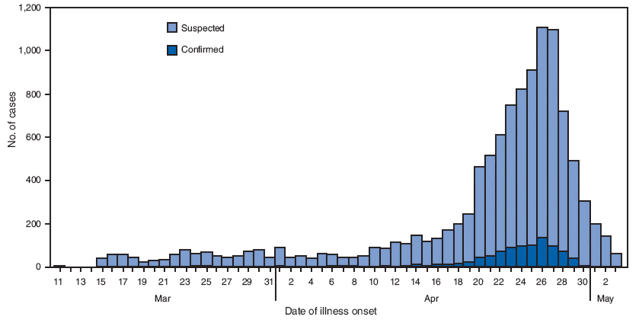There are some interesting statistics on influenza in the current issue of CDC’s Morbidity and Mortality Weekly Report. The first is this map showing the number of confirmed cases (N = 1,882) of novel influenza A (H1N1) virus infection worldwide as of May 6, 2009:


With the exception of a few countries, the vast majority of confirmed cases have been in the northern hemisphere. I suspect this situation will change rapidly – flu season is winding down in the northern hemisphere, and is about to begin in the south. The fact that there are already confirmed cases in the southern hemisphere means the virus is already there, and likely to spread further. CDC says as much, although with considerably more uncertainty:
Summertime influenza outbreaks in temperate climates have been reported in closed communities such as prisons, nursing homes, cruise ships, and other settings with close contact. Such outbreaks typically do not result in community-wide transmission, but they can be important indicators of viruses likely to circulate in the upcoming influenza season. The novel influenza A (H1N1) virus has been circulating in North America largely after the peak influenza transmission season. For that reason, the epidemiology and severity of the upcoming influenza season in the southern hemisphere or in the northern hemisphere cannot be predicted. The imminent onset of the season for influenza virus transmission in the southern hemisphere, coupled with detection of confirmed cases in several countries in the southern zone, raise concern that spread of novel influenza A (H1N1) virus might result in large-scale outbreaks during upcoming months. Countries in the southern hemisphere that are entering the influenza season should anticipate outbreaks and enhance surveillance accordingly. Influenza virus can circulate year round in tropical regions; therefore, these countries should maintain enhanced surveillance for novel influenza A (H1N1) virus.
Also shown in bar graph form are the number of confirmed (N = 822) and suspected (N = 11,356) cases of novel influenza A (H1N1) virus infection, by date of illness onset in Mexico, from March 11 – May 3, 2009:


These data suggest several interesting possibilities. Infection with the new H1N1 strain might have begun as early as March 11, although the early cases are suspected, not laboratory confirmed. After a period of relatively few infections, the number of cases rapidly climbed to a peak and then quickly declined. Of course, new outbreaks are still possible. If we take the number of deaths in Mexico (42) and divide them by the number of laboratory confirmed cases (949), the mortality rate is 4.4% – higher than the 2.5% observed during the 1918-19 pandemic. However, if we divide the number of deaths by the number of suspected cases (11,932), the fatality rate is more in line with typical seasonal influenza – 0.4%. Which number is correct awaits determination of the actual number of cases.
It is also informative to examine CDC’s case definition for influenza – fever plus cough or sore throat. This definition is very broad and could easily include infections caused by other respiratory viruses, such as rhinoviruses, coronaviruses, adenoviruses, and paramyxoviruses. Indeed, I have heard that some of the suspected cases of H1N1 influenza in New York are in fact a consequence of rhinovirus infection. Analyzing an outbreak by using the suspected number of cases is dangerous – akin to a scientist ‘wasting clean thoughts on dirty data’.

Sincere thanks for your informative comments.
I have specifics question that I try to find an answered for.
What is precisely the Avian component of this new H1N1.
And in the M-3 gene segment related to the temperature ?
Thank You
Snowy
Pingback: Racaniello crunches some numbers | Swine Flu Daily Update
The PA and PB2 genes are derived from avian influenza viruses, which
entered pigs in the late 1990s. I'm not sure what you are asking about
the M protein.
Pingback: 轉載: æµæ„Ÿï¼Žè±¬å ´ï¼Žé›žå ´ï¼Žballå ´ « ä¸å†æ†‚鬱的亞熱帶
There will be times when new unkown sickness will appear on earth. Medicine will not know how to cure them. But there is hope for those that want to do the work. A free gift for humanity is available. No group to join, no money required. Any human being, regardless of skin color, religion, political or religious position has the potential within. Please ask for a free book at http://www.hercolubus.tv. It has the practices to prepare yourself. No one can do the job for you. You and you alone can prepare for what is already happening: Floods, Earthquakes, Global Warming, Pandemics, World wars etc.
I'm normally very healthy, until this April, 2009 when I became ill with a nasty sore throat, cough and fever…no vomiting. I've been put on two antibiotics, which help the symptoms to go away; then a few weeks go by and the sore throat comes back and will NOT go away. What IS this virus??? I'm a constant hand washer…VERY clean, almost germaphobic. Is this possibly the new swine flu and how is one tested for it?
A throat swab can be used to determine if you are infected with the
2009 H1N1 influenza virus. However, by now it is not likely to be
present any longer. To determine if you were infected, it would be
necessary to draw blood and determine if it contains antibodies to the
virus. However, this type of assay is not usually done by primary
health care workers.
What I can say is very nice and helpful as well as informative post…really help me very much more!! Thanks..
Cheers,🙂
sain-web.com
We are looking for influenza A H1N1 qualitative/quantitative detection kits/swabs
We are looking for influenza A H1N1 qualitative/quantitative detection kits/swabs,
surya@majlan.com
surya@majlan.com
cas
meon
We are looking for influenza A H1N1 quantitative detection kits.
For more jobs visit http://www.staffingpower.com
We are looking for influenza A H1N1 quantitative detection kits.
For more jobs visit http://www.staffingpower.com
Was the N1H1 really that serious or were the drug companies just trying to make money!
Has there been any mention of H1N1 cases for 2010 flu season?1